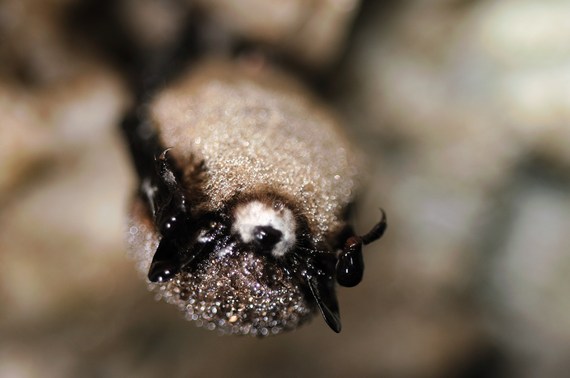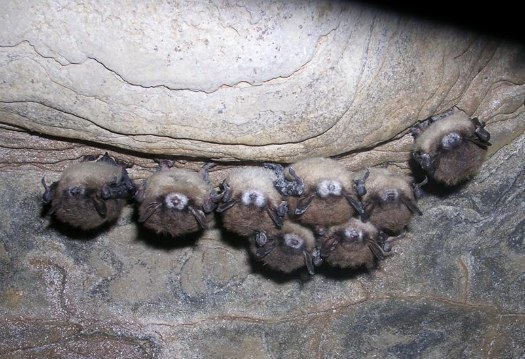For the past decade, an epidemic called White-Nose Syndrome has had severe impacts on bat populations throughout North America. The fungus, Pseudogymnoascus destructans, feeds on soft tissues of bats such as their wings and noses.

Little Brown Bat with white-nose syndrome
Credit: Jonathan Mays, Wildlife Biologist, Maine Department of Inland Fisheries and Wildlife
White Nose Syndrome was first discovered in Haile's Cave at John Boyd Thacher State Park by the New York State Department of Environmental Conservation during a routine bat survey in March 2007. The earliest evidence of the disease in North America can be seen in photographs taken by a cave hydrologist at Howe Caverns in Schoharie County, New York in the winter of 2006. New York State DEC states that since March 2007 "we discovered the disease in every hibernation site in New York in which we have looked for it." The U.S. Fish & Wildlife estimates a death toll between 5-7 million bats based on the most recent survey conducted in 2012.
Impacts of the disease on hibernating bats have varied between species. According to the NYS DEC, "the Northern long-eared bat and the tri-colored bat are most impacted. Observed declines for these species exceed 95 percent on a statewide basis. The little brown bat, once very common, has declined about 90 percent. The Indian bat, a species that was considered endangered even prior to white-nose, has been slightly less affected as a percentage, exhibiting perhaps 70 percent decline statewide."

Bats exhibiting Pseudogymnoascus destructans fungus on their muzzles. This fungus causes WNS in bats.
Photo Courtesy of Nancy Heaslip, New York Department of Environmental Conservation
Michelle Verant, Post Doc at the USGS National Wildlife Center at the University of Wisconsin, published a study this past December on how the disease progresses from initial infection to mortality in bats. Verant states "bats have reduced immune function in hibernation, making them susceptible to the disease." The study found that the fungus fluctuates in growth substantially based on temperature with ideal conditions between 12-15 degrees Celsius (53-59 degrees Fahrenheit). Those conditions also happen to be the body temperature range of most bats during hibernation. The fungus inhibits the bat's ability to release CO2 from their bodies. Verant attributes the increased energy use during infection to high levels of built up CO2 found in infected bats. She states, "as the fungus feeds on the bats soft tissues, it increases the metabolic rate of the bats compounded with the damage to the wings that aid in passive release of CO2 from the bat." The spike in C02 levels in the bats causes them to hyperventilate, increasing arousal frequencies during hibernation, leading to fatal starvation.
The fungus most likely originated in Europe. Jeff Foster of the Department of Molecular, Cellular and Biomedical Sciences at the University of New Hampshire, is one of the leading researchers genetically tracing the origins of the fungus. His lab results have demonstrated that the North American strain and European strains of the fungus do not produce mortality in European bats, but both do so in North American bats. Based on his findings, Foster hypothesizes that episodes of mass mortality in European bat populations have historically occurred until bats developed immunity to the disease and that small numbers of surviving bats in North America will likely do the same. He states "the genetic testing of the fungus in Europe suggests that is has existed there for millennia, whereas the North American variation of the fungus strongly suggests it was introduced very recently as very little genetic variability has occurred." Foster and many other researchers suspect that the fungus was brought over from Europe inadvertently on cave gear or clothing. This suspicion has led to strict regulations on cave access throughout potentially affected areas.
At Mammoth Cave National Park, White Nose Syndrome has affected the visitor procedures for entering and leaving the caves since the emergence of the disease in New York.
According to Rickard S. Toomey III, Director of Mammoth Cave International Center for Science and Learning,
From 2008 until the winter of 2010-2011, park efforts on White Nose Syndrome spread prevention focused on keeping people from bringing the fungus that causes White Nose Syndrome into park caves. Visitors were screened to see if they had visited other caves since 2005. Those that had were asked about their shoes and clothing. If necessary, shoes were treated with a cleaning solution to kill any fungal spores that might be on them.
In 2011, the existence of White Nose Syndrome was confirmed in the state of Kentucky, and the park's precautionary efforts extended to requiring all visitors who went on walking tours to sanitize their shoes on bio-security mats in case the fungus existed at the park undetected. From 2011 until Spring 2014, spread prevention efforts simultaneously targeted preventing the fungus from coming to the park with people and preventing people from leaving the park with viable fungus (in case it was already there, but undetected).
By spring 2014, White Nose Syndrome was confirmed on tour routes. Toomey states "since 2014, primary concern with spread has been to minimize potential for visitors to spread the fungus to other sites after visiting Mammoth Cave."
Some colonial bat roosts in the park have been closed to most access, to reduce potentially spreading the disease and exacerbating the disease in infected bats. On cave crawling tours Toomey states, "we no longer allow people to use their own caving gear. The park supplies coveralls, pads, helmets, lights, and gloves. These gear are only used on these tours and do not leave the park. Visitors use their own boots, but the boots are cleaned following the tours. The gear restriction addresses both the potential for people to accidentally bring the fungus into the cave and keeps people from leaving with it, now that the fungus is here." The gear and access restrictions, according to Toomey, have not significantly impacted park attendance.
National White Nose Syndrome Coordinator at U.S. Fish and Wildlife, Jeremy Coleman, was a graduate research assistant at Cornell University when White Nose Syndrome first emerged. In 2008, a meeting in Albany, New York brought together Federal, State, Non-Government and research organizations to develop a response plan to the epidemic. The Northeast Regional U.S. Fish & Wildlife office in Hadley, Massachusetts was designated the lead in overseeing the National response. According to Coleman,
"The disease is still advancing and has been confirmed in 25 U.S. States and five Canadian Provinces to date, with pending lab results that may add another three states to that map. Bats can travel hundreds of miles from their roosting sites, so the impacts of the disease affect their entire range and not just the counties in which their roosting/hibernating sites reside. The disease isn't going away anytime soon."
Reports of the disease have decreased this year in the Midwest, but Director of Imperiled Species at Bat Conservation International Katie Gillies states, "the decrease in the Midwest is due to bat movement patterns rather than any actual decline in the spread of White Nose Syndrome." Gillies cites the biggest breakthrough in fighting the disease of recent has been the research on creating a biological control for the disease.
Possible hope for the bats is in development. At Georgia State University's Crow Laboratory, Chris Cornelison was conducting research with the bacteria Rhodococcus to delay the ripening of fruit. His findings showed a significant decrease in fungal growth on the fruit and he was curious as to whether it could produce the same results on bats infected with White Nose Syndrome. In conjunction with the U.S. Forest Service, his research has demonstrated that the bacteria stop germination of the fungus on bat tissue without any negative effects. His team developed a nebulizer to distribute the bacteria at a very low cost and recently conducted a field trial at four sites in Kentucky. Cornelison states that "the field trial results have yet to be published, but regardless of how well it works, the diverse environments that bats inhabit throughout North America call for a diversity of tools needed to combat White Nose Syndrome so that the resource management of each particular jurisdiction can utilize the right tool to mitigate the impacts of the disease for each specific ecosystem."
Official White Nose Syndrome Website http://www.whitenosesyndrome.org
